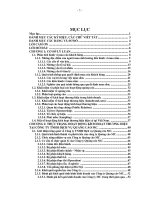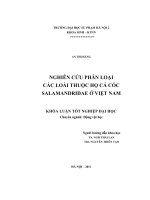Báo cáo khóa luận thực tập israel USING OF THE PREDATORY PHYTOSEIULUS PERSIMILIS TO MONITORING AND CONTROLLING FOR TWO SPOTTED SPIDER MITE ON CHERRY TOMATO, OFER ELAD FARM, KMEHIN
Bạn đang xem bản rút gọn của tài liệu. Xem và tải ngay bản đầy đủ của tài liệu tại đây (7.68 MB, 35 trang )
USING OF THE PREDATORY PHYTOSEIULUS PERSIMILIS TO
MONITORING AND CONTROLLING
FOR TWO- SPOTTED SPIDER MITE
ON CHERRY TOMATO,
OFER ELAD FARM, KMEHIN
FARMER : OFER
ADVISOR: AVNER LEVY
Students:
NGUYEN MAU HOANG SANG
LE HAI DANG
Ramat Negev international training center for advanced agriculture
Class 2 of 2015-2016
I. ABSTRACT
This research aims to effective of the use natural enemies from offering conclusions for the
cherry tomato. The whole process of implementation reports from 10/2015 to 3/2016 at
OFER’s farm. CHERY TOMATO are fruit vegetables very popular, in addition to some
effects for good healthy, the cherry tomato is also considered as a fruit vegetable.
So just how do farmers increase production without harm to user's health. One of the
solutions that is use natural enemy persimilis for cherry tomato helps to reduce the use of
chemicals and provide sustainable yields.
I. ABSTRACT
The use of natural enemies at different times to help farmers determine the extent
and time of use of natural enemies to profitable results.
However, to provide the most effective measures, in addition to use of natural
enemies should also incorporate other measures, such as exclusion, sanitation, etc.
And the limitations when working in the greenhouse to avoid damage and control
insects and diseases better when using natural enemies.
II. INTRODUCTION
Currently. In the field of agriculture, the user of chemicals has caused serious
consequences affecting species and humans.
Figure1: use chemicals in
agriculture.
Why rely on chemical pesticides does not control crop
pests?
On Earth there are about 1 million insect species, of which about 5 thousand
types of herbivorous and only about 1% (about 500 insects) specializing in food
crops and fruit trees. Although the number of types not many but they are very
voracious and eat very well, causing great harm to crops, vegetables, fruit trees.
(1)
Table 1: According to statistics, every year insects caused
in China .
DAMAGE BY INSECTS (%)
TOTAL(%)
FOOD
10
100
VEGETABLE OIL
20
100
VEGETTABLES
30
100
FRUITS
40
100
II. INTRODUCTION
Solution to this problem?
Today, it is the application of integrated measures to deal with pests, including insects measures
using insecticides and using insecticide germs and pay special attention to the protection of birds that
feed on harmful insects. In addition it also causes, breeding and importing all kinds of beneficial
insects to kill pests. Only then can prevent environmental pollution and effectively control the
harmful insects. So we are have made this topic “USING OF THE PREDATORY PHYTOSEIULUS
PERSIMILIS
FOR
TO
TWO
MONITORING
-
AND
SPOTTED
ON CHERRY TOMATO, IN OFER ELADFARM, KMEHIN”
SPIDER
CONTROLLING
MITE
photophilic not
not sow
sow seedlings
seedlings in
in shady
shady places,
places, minimum
minimum intensity
intensity to
to tree
tree growth
growth is
is 2000-3000
2000-3000 lux,
lux, not
not influenced
influenced by
by photoperiod.
photoperiod.
photophilic
•
Water Requirements
Requirements of
of the
the tree
tree during
during the
the same
same diet.
diet.
Water
•
accretion moisturizing
moisturizing and
and drained
drained and
and contains
contains aa minimum
minimum of
of 1.5%
1.5% of
of organic
organic matter
matter on
on soil
soil SUITABLE
SUITABLE pH
pH 5.5
5.5 to
to 7.0.
7.0.
accretion
•
Soil and
and
Soil
nutrients
nutrients
Water
Water
Lighting
Lighting
Temperature
Temperature
variety of ways: (2)
CHERY TOMATO are fruit vegetables very popular because of good quality and processing are a
•
21-24oC, if
if lower
lower night
night temperatures,
temperatures, the
the plants
plants for
for several
several days
days 4-5oC
4-5oC certain
certain flowers.
flowers.
21-24oC,
II. INTRODUCTION
II. INTRODUCTION
When cherry tomato grown in greenhouses under attack by insects and disease can
cause severe crop failure.
Example: spider mite cause damage by eat leaves cherry tomato and reduce yield. So
what can farmer to controling and mornitoring spider mite? How to manage
effectiveness methods, good for environment and human?
II. INTRODUCTION
(IPM) Integrated pest management, also known as Integrated Pest Control (IPC) is a
broad-based approach that integrates practices for economic control of pests. IPM aims to
suppress pest populations below the economic injury level (EIL).
The UN's Food and Agriculture Organisation defines IPM as "the careful consideration of
all available pest control techniques and subsequent integration of appropriate measures
that discourage the development of pest populations and keep pesticides and other
interventions to levels that are economically justified and reduce or minimize risks to
human health and the environment. (3)
II. INTRODUCTION
Successful crop production requires that crop insects and diseases be managed so that
the effects of diseases and pests on the plants are minimized.
There are methods to control insects and pests are: Exclusion keeping insects from
entering the greenhouse, is a key part of greenhouse insect management. Many common
pests that attack greenhouse tomatoes are small flying or wind-borne creatures that can
easily be sucked into the greenhouse through ventilation fans and cooling pads or can
easily enter through other openings.
III.Material and methods
smartphone
laptop
Material
gloves
Figure 2: thermometer in farm
White Papers, pen,
thermometer.
Methods
CHART OF REPORT METHODOLOGY.
Take pictures and catch
Collect insects and diseases in
insects .
farm
Methods of data collection (from
Experimental observation methods Statistical
methods
described
characteristics)
(shape,
lifespan,
the internet ..) and FAQs direct
Conclude
(farm owners and instructors)
Topic implemented form 3/2016 to 10/2015 at farm 1 & farm 3. In which farm 3 by the
influence of Tomato yellow leaf curl virus should take famer less weeds in farm hygiene
measures and when used combination persimilis. 1, the normal farm also.
Figure 4 : farm 3
Figure 3 : farm 1
Ways
determine the number persimilis and spider:
In each row of tomatoes and random grab 5 leaves in place evenly spaced in rows. Then
using human eye to observe and count the insects move on white paper. Repeat 3 times
experiments
in
widely
separated
locations
in
the
farm.
Based on available data and then calculate the average of:
i: The number of times experiments.
Y: area of leaf (cm2).
X: number persimilis or spider.
IV. RESULT
Identification the spider mite on farm
•
•
Spider mites is oval in shape. They have eight legs, except as a nymph.
About 1/20 inch long. The colour varies from light to dark green, but it can sometimes
also be brown or orange.
•
Spider mites live in colonies, mostly on the undersurfaces of leaves, a single colony may
contain hundreds of individuals.
Identification the spider mite on farm
•
The male is a little bit more mobile, smaller and more slender than the oval female. The
female deposits round eggs of about 0.14 mm on the underside of the leaf.
Figure 5: Adult female twospotted spider mite,
Tetranychus urticae Koch, and her eggs. Photograph
by James F. Price, University of Florida.
Figure 6: life cycle of spider mite
Life cycle of spider mite:
optimal conditions 27 °C.
hatch in 3 days.
sexually mature in 5 days.
A single mature female can spawn a population of a million mites in a month.
live for 2 to 4 weeks.
Greater pesticides adaptation.
These begin feeding on leaf tissue and soon molt into eight-legged nymphs. The
nymphs then develop into sexually mature adults.
Day
36
Duration
of a
developme
nt cycle
13
7
6
0
0
Temperature oC
Chart 1: duration of a development cycle of spider mite.
Source: Sebastian Bayer Applied Entomology
Damage on cherry tomato:
Mites cause damage by sucking cell contents from leaves. At first, the damage show up as a
stippling of light dots on the leaves; sometimes the leaves take on a bronze color.
As feeding continues, the leaves turn yellowish or reddis and drop off.
=> Loss of leaves can have a significant impact on yield and lead to sun burning.
Figure 7 . leaves infected by spider mite causes.
How to monitoring spider mite on farm?
Usually notice plant damage such as stippled or yellow leaves before you spot the
mites themselves.
Check the undersides of leaves for mites, their eggs and webbing.
Sometimes the mites will be gone by the time you notice the damage; plants will
often recover after mites have left.
Confirm the presence of spider mites.
Spider mites are so small, they can be very difficult to see. However, one method you can use to confirm their
presence is to take a sheet of white paper, place it beneath the plant you suspect to be infested and lightly shake
the stem of one of the leaves.
Figure 8: use white paper to
identify the spider mite.
Description of Phytoseiulus persimilis:
Persimilis is a tropical predatory mite that was one of the first greenhouse biological control
agents available commercially.
• Eggs are oval and <1/50 inch (0.3 mm) long, oval shaped; pale translucent yellowish pink color;
deposited near spider mite populations and about 3 times larger than spider mite eggs.
• Larvae are inactive, a pale salmon color and have 6 legs. (4)
Figure 9: phytoseiulus
persimilis
Description of Phytoseiulus persimilis:
• There are two nymph stages; both are a pale salmon color, have 8 legs, and are very active
predators.
• Adults are bright reddish orange, with long legs and pear-shaped bodies, 1/50 inch (0.5 mm) long.
Both adult and immature predators move rapidly over the leaves and both feed on two-spotted
mite eggs, nymphs, and adults. Unlike its prey, Persimilis does not spin webbing.









